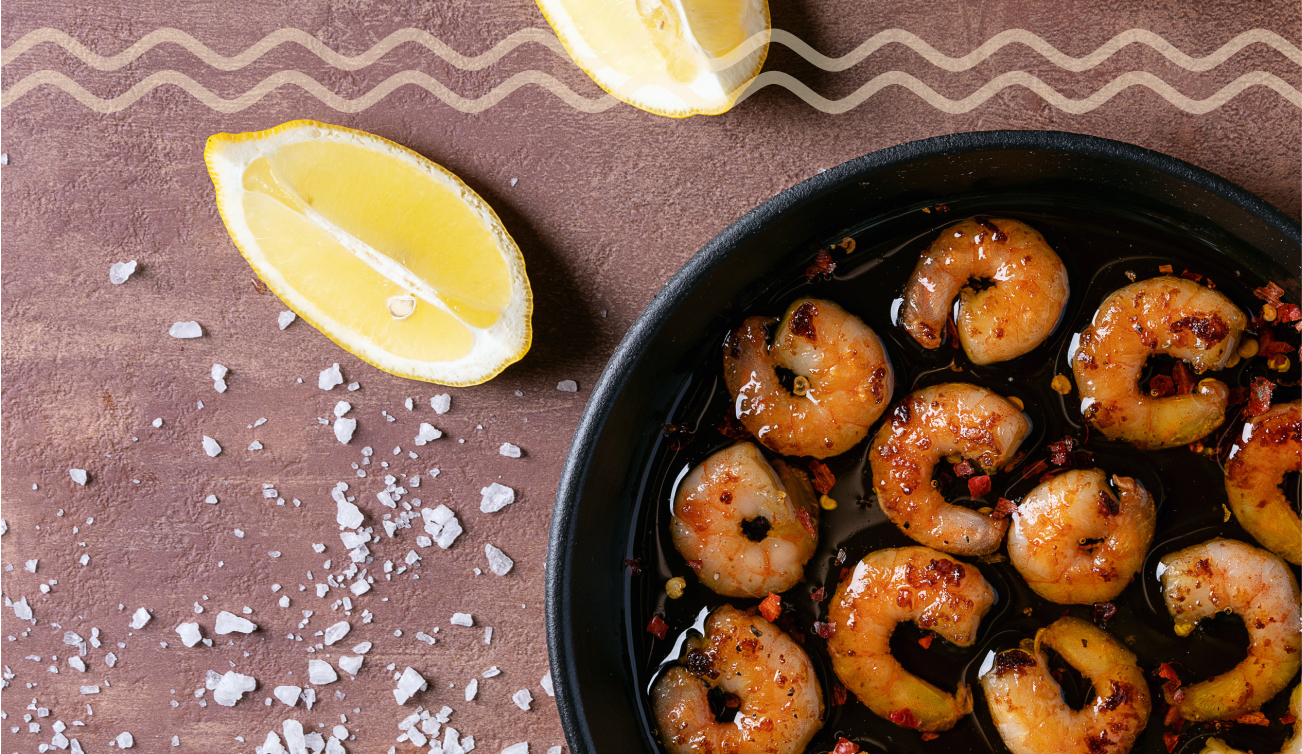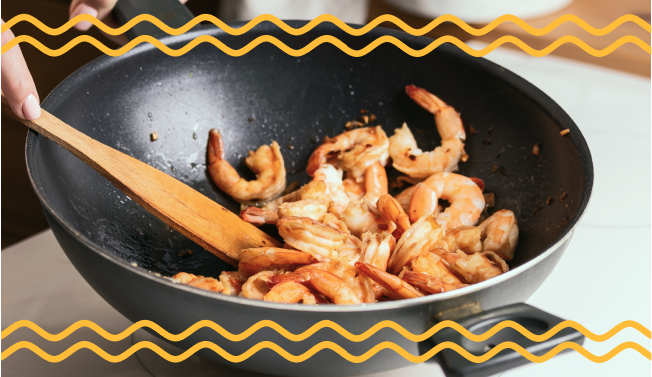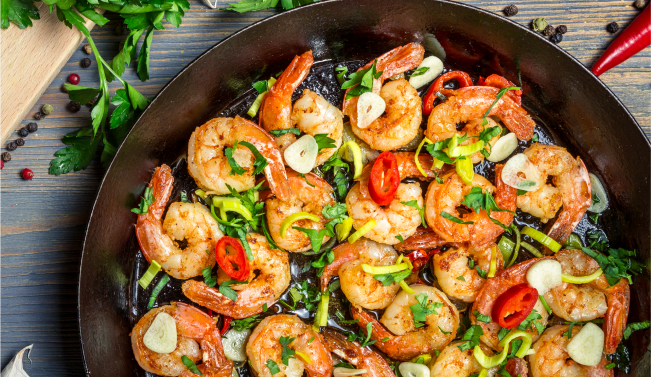How to Cook Wild-Caught Shrimp Perfectly Every Time
Texas Gold Shrimp on 15th Aug 2024
The smell of shrimp, sautéed with garlic and butter wafting through the kitchen. The first bite of the rich, succulent meat as the juices from your Texas Boil fill your mouth and bathe your tastebuds in that perfectly salted and delicate meaty flavor.
Shrimp is undoubtedly one of the most versatile meats you can cook. Nothing beats fresh Texan shrimp. The great thing is that once you know how to cook shrimp perfectly, it’s a reliable, easy, quick, and delicious way to impress.
There are lots of ways to cook shrimp, but it all starts with selecting the best wild-caught shrimp for your dish. From there, you can grill, sautee, poach, or stew them – each method giving a unique taste and a personal take.
Here at Texas Gold Shrimp, we’ve cooked a fair few shrimp dishes in our time. Below we’ve distilled the most common questions about how to cook shrimp, what shrimp to buy, how to devein shrimp, the best way to thaw shrimp, and finally how to prepare it. And if you need inspiration, head over to our recipe section.
Following these tips will help you to make sure you create a succulent Texan staple for your friends and family every time.

What Shrimp to buy?
Wild-Caught vs. Farm-Raised
Wild-caught shrimp come from natural waters including the ocean but also other bodies of saltwater like estuaries. Their meat is firm and their flavor more vibrant. This is because of their varied diet which includes things like plankton and small marine creatures. While they offer a better flavor and can be more nutritious, supply is more seasonal.
Farm-raised shrimp grow up in controlled environments with carefully controlled diets. This gives them a softer texture and more mild taste. They are available all year round but can have a less complex nutritional profile.
How to tell when Shrimp Is fresh?
The best dishes will use the freshest shrimp. Some telltale signs that your shrimp might be past its best – look for discoloration or slime. If they appear limp or have lost their firmness, this means they are not fresh. By far the easiest (and most unpleasant) way to tell if you’re shrimp has turned is the smell. Bad shrimp will have an ammonia tang.
One of the freshest options (short of catching them yourself) is choosing flash-frozen shrimp. These are frozen at sea, immediately locking in their flavor and nutrients until they can be thawed and prepared.
For fresh shrimp, always ask when and where they were caught. They should be firm with a mild sea-water aroma.
How big are shrimp?
Shrimp are sold by size which is usually measured by “count per pound”.
Larger shrimp are sold in smaller numbers, in the range of 16 to 20. These are perfect for grilling or roasting. Smaller shrimp are perfect to add that salty bite to a salad or to dip in rich sauces as a snack. They will range from 70 to 90.
It’s essential to consider the right size for your dish. For example, large shrimp do well at high heat. The short cooking time locks in the juices meaning they remain succulent when served.
Shrimp farming has become far more sustainable in recent years so feel free to ask about sustainability and environmental considerations with your supplier – they’ll be happy to talk about it!

How to Prepare Shrimp: A Step-By-Step Guide
Thawing Shrimp
For the best possible flavor and texture, we recommend properly thawing your shrimp before preparing it.
Take your shrimp out of the freezer the day before cooking and leave them in the fridge. The gradual thawing process maintains that firm texture and those mild seawater notes that you can build on with your preferred seasoning. This will take anywhere between 12 and 24 hours.
Then, absorb any excess moisture by placing the shrimp on a paper towel. Voila, you have shrimp that’s close to catch fresh and ready to go.
Sometimes you might need to thaw your shrimp more quickly (we all have those emergencies!). In this case, simply put your frozen shrimp in a sealed plastic bag with cold water for about 30 minutes.
A top tip is to make sure you change the water halfway through to ensure that they thaw evenly.
Deveining
Deveining shrimp is the removal of the shrimp’s digestive tract. This is not essential but for the best eating experience, we recommend it. It ensures your dish is colorful and that the texture doesn’t contain any grit.
Take the back of the shrimp and use a pairing knife to make a shallow incision along its back. You want to expose the dark vein there. Then, using the knife (or a toothpick works equally well here too) you can remove the vein. Do this over a paper towel to make cleaning up easier. This is great for small numbers of shrimp, but you can also find specialist deveining tools for larger quantities.
Seasoning Advice
The seasoning is the thing that makes or breaks a shrimp dish. At its most basic level you can use simple seasoning – lemon juice with salt and pepper are ever popular. The salt enhances the natural flavour of the shrimp, the pepper adds depth and spice while the lemon juice helps to release the natural flavor and provide freshness and a delicate contrast to the salt-water flavor.
You can marinate shrimp using oils, herbs, spices or butter. Garlic is very popular, along with cilantro or dill. For a quicker marinade, consider using cider or red wine vinegar. Do not over-marinate as this will ruin the texture. This is perfect for grilling or sauteeing and the marinate helps to stop the shrimp from drying out as easily.
You can also use dry rubs and spice blends. You can make these yourself or lean on the wisdom of generations and buy artisan rubs from one of the many spice specialists throughout the state.

How to Cook Perfect Shrimp
How to Sautée Shrimp
Sautéeing shrimp is a really easy and quick way to prepare them, releasing the natural flavor while infusing your own spice mix. It’s also a great way to maintain their texture.
Start by heating a large skillet over medium-high heat and add a combination of olive oil and unsalted butter. Once hot, add the shrimp seasoned with kosher salt and freshly ground black pepper. Include your spice mix at this point.
Cook the shrimp for about 4 to 5 minutes, stirring occasionally, until they turn pink and opaque. This method is perfect for creating a delicate and succulent dish that can be prepared and served really quickly
How to Grill Shrimp
If you’d like to find that definitive Texas smoky flavor, grilling is the way to go.
For the perfect grilled shrimp, preheat your grill to medium-high heat. Season the shrimp with things like olive oil, minced garlic, red pepper flakes, and fresh lemon zest. Thread them onto skewers and space them out to ensure they cook evenly. Grill the shrimp for 2-3 minutes per side, being very careful to avoid overcooking.
Your shrimp are ready when they turn pink and curl into a 'C' shape. For an added mouthwatering kick, serve with a brush of garlic herb butter.
How to Poach Shrimp
Poaching provides a more delicate and healthier alternative to preparing your Shrimp. Bring a pot of water to the boil and allow it to simmer. Add salt, lemon juice, wine, and your preferred spices.
Add the shrimp and then remove the pot from the heat, covering it to let the shrimp cook gently. This method is creates shrimp that are tender and succulent, making them perfect for salads or shrimp cocktails.
How to Roast Shrimp
An easy and hands-free method is to roast your shrimp. Preheat your oven to 400 degrees F.
Toss your shrimp with olive oil, salt, and pepper, and roast for 6-8 minutes. You want to make sure they’re pink and firm before serving.
Take care as ovens can vary and overcooking can lead to tough shrimp.
Some top tips – never overcrowd your pan or grill as this is a surefire way to have unevenly cooked shrimp. Make sure they’re thawed out properly so that you avoid undercooking them.

Expert Tips and Tricks for Cooking Shrimp
How to Prevent Overcooking Shrimp
Overcooked shrimp are tough, chewing, and flavorless. The easiest way to avoid overcooking is to be cautious of cooking times. They are very quick to prepare and rarely need more than a few minutes at a high heat.
The color change is crucial. They are ready when they turn pink and the flesh is opaque rather than the grey or silvery color you see when they’re fresh.
They will continue to cook after they’ve been removed from the pan or grill so it’s advisable to let them rest and finish cooking with the residual heat. Needless to say, make sure that your shrimp are cooked through before serving and eating.
How to Use Shrimp Shells for Stock
Once the plates are empty and bellies full, it would be tempting to throw away all the shells. But, with very little preparation, they can be turned into a delicious stock for paella, risotto, soups, or sauces.
Simply sautee the shells to caramelize them. This unlocks even more flavor. Then, add water and simmer for about 5 to 7 minutes before straining.
Your stock can be stored in the fridge for up to four days or frozen for a rainy day for up to four months, ready to go into a future dish to provide depth and flavor.
Perfect Presentation
Cooked shrimp has a beautiful pink color that you can enhance with different vegetables and sauces. Red pepper, green herbs like dill or cilantro, or maybe the yellow of lemon slices can all be used alongside the soft pink of the shrimp to create a captivating and visually alluring dish. Sauces like chimichurri or mango salsa look beautiful while also providing a lovely acid tang.
Other things you can play with include height – stacking shrimp or organizing them around a central risotto for example. Ensure your plate has symmetry by using thoughtful garnishes like herbs or edible flowers. Use skewers or different styles of plates to highlight their natural shape.
By being thoughtful and playful, you can create bold and creative dishes that also taste amazing.
Remember that our online store has a wide variety of shrimp for a variety of dishes. Order now and get flavorful shrimp delivered to your door.
FAQs
What is the most delicious method to cook shrimp?
This depends on your taste and preference but one of our favorites because it's super tasty and really easy is to roast them.
Preheat your oven to 450°F (232°C). On a baking sheet, mix shrimp with salt, garlic, olive oil, red pepper flakes, and lemon zest. Allow the mixture to sit for 10 minutes. Roast the shrimp for 7 to 9 minutes until they turn pink and are just cooked through. Remove them from the oven, add butter, and toss to coat. Finish with a spritz of fresh lemon juice for extra flavor.
How should wild shrimp be prepared for cooking?
To prepare wild shrimp for cooking, it’s essential to thoroughly clean them.
This includes deveining and removing the shell if desired (see our section on deveining for more information).
Rinse them under cold water and pat them dry or place them on a paper towel
Depending on your recipe, you might want to consider marinating them and adding seasoning before you start cooking.
How can I cook shrimp without making them rubbery?
This is all about timing. Cook the shrimp without moving them. For medium-sized shrimp, 2 minutes is sufficient. For larger shrimp, aim for 3 minutes. If they’re jumbo shrimp, it’s 4 minutes.
After their initial cooking, flip the shrimp and cook for another 1 minute for medium, 1-2 minutes for large, or 2-3 minutes for jumbo shrimp, just until they are cooked through.
Remember, they will keep cooking for a short time after they’re taken off the heat so be sure to factor that in when you’re preparing them.
As always, ensure that your shrimp are cooked through before eating them.

